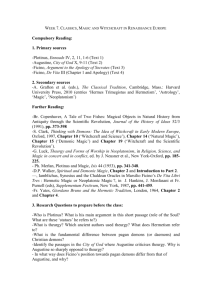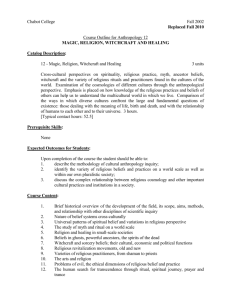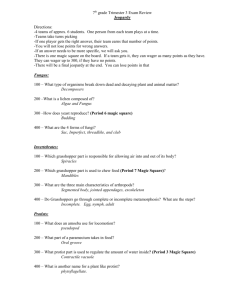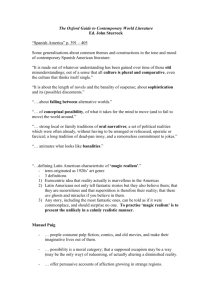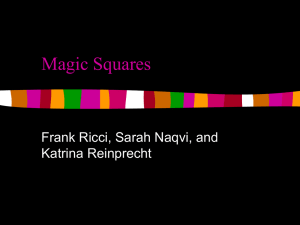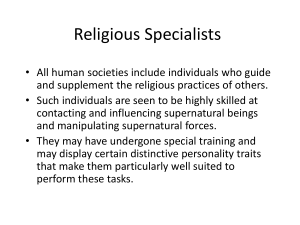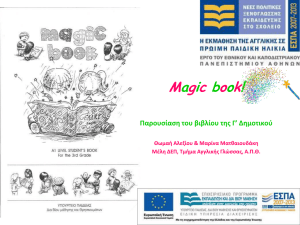ANT 1010. Culture and Human Experience. Redwood
advertisement
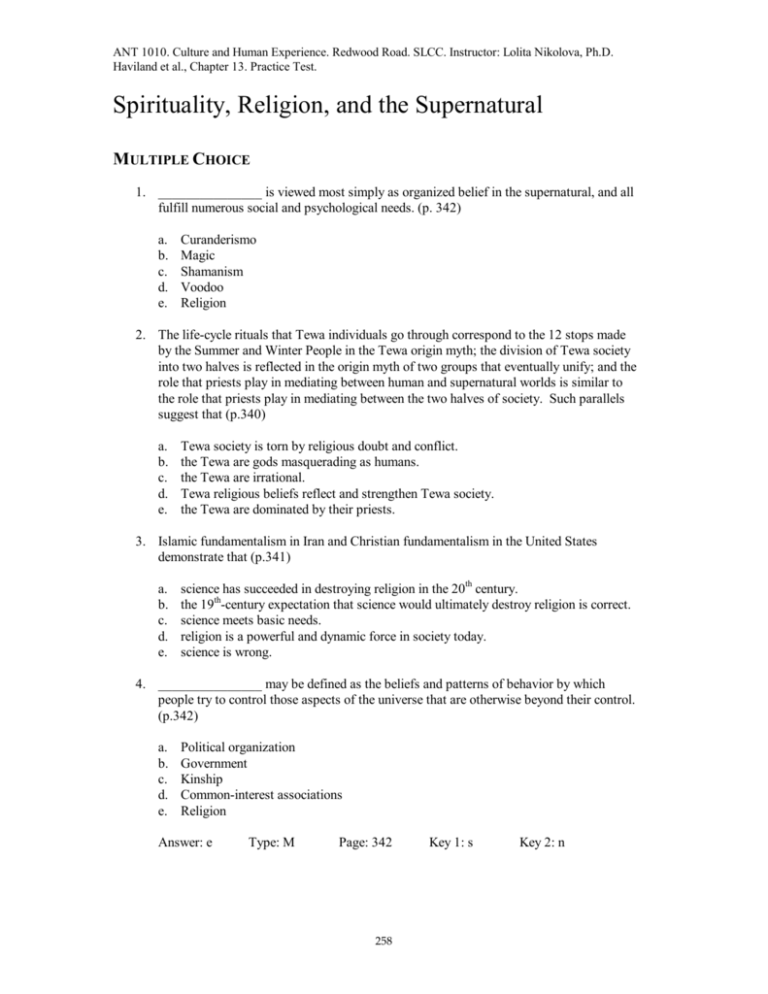
ANT 1010. Culture and Human Experience. Redwood Road. SLCC. Instructor: Lolita Nikolova, Ph.D. Haviland et al., Chapter 13. Practice Test. Spirituality, Religion, and the Supernatural MULTIPLE CHOICE 1. _______________ is viewed most simply as organized belief in the supernatural, and all fulfill numerous social and psychological needs. (p. 342) a. b. c. d. e. Curanderismo Magic Shamanism Voodoo Religion 2. The life-cycle rituals that Tewa individuals go through correspond to the 12 stops made by the Summer and Winter People in the Tewa origin myth; the division of Tewa society into two halves is reflected in the origin myth of two groups that eventually unify; and the role that priests play in mediating between human and supernatural worlds is similar to the role that priests play in mediating between the two halves of society. Such parallels suggest that (p.340) a. b. c. d. e. Tewa society is torn by religious doubt and conflict. the Tewa are gods masquerading as humans. the Tewa are irrational. Tewa religious beliefs reflect and strengthen Tewa society. the Tewa are dominated by their priests. 3. Islamic fundamentalism in Iran and Christian fundamentalism in the United States demonstrate that (p.341) a. b. c. d. e. science has succeeded in destroying religion in the 20th century. the 19th-century expectation that science would ultimately destroy religion is correct. science meets basic needs. religion is a powerful and dynamic force in society today. science is wrong. 4. _______________ may be defined as the beliefs and patterns of behavior by which people try to control those aspects of the universe that are otherwise beyond their control. (p.342) a. b. c. d. e. Political organization Government Kinship Common-interest associations Religion Answer: e Type: M Page: 342 258 Key 1: s Key 2: n 5. Which of the following is LEAST likely to be extensively involved in religious beliefs and activities? (p. 342) a. single women with ten children living below the poverty line, who dropped out of school at age 14 b. members of food foraging societies with limited scientific knowledge c. peasants in a feudal society d. members of lower classes in an urban-industrial society e. wealthy members of urban-industrial societies with advanced scientific knowledge 6. A people’s collection of gods and goddesses is called a (p.343) a. b. c. d. e. mana. shaman. pantheon. priest. fetish. 7. The belief that nature is animated with spirits is called (p. 345) a. b. c. d. e. animation. anima. animatism. animism. ennui. 8. The major difference between animism and animatism has to do with whether the supernatural force which occupies an entity is (pp. 345, 346) a. b. c. d. e. personal or impersonal (a being or an impersonal force without identity). natural or supernatural. a god or an ancestral spirit. a priest or a shaman. an example of witchcraft or of divination. 9. Which of the following is an example of animism? (p.345) a. b. c. d. e. a lucky baseball bat the goddess Athena in Greek mythology the god Zeus an ancestral spirit the malevolent spirit inside your baseball who jumps erratically through the air just as you think you’re about to hit a home run 10. In acting as a healer, the shaman (p.348) a. provides reassurance to the community through an elaborate drama that may involve trickery. b. may use modern medical techniques. c. may be coping with his/her own problems by becoming intensely involved with the Chapter 13—Spirituality, Religion, and the Supernatural 259 problems of others. d. may improve the patient’s state of mind, which aids in recovery. e. all but b 1. Ceremonies such as bar mitzvahs, elaborate wedding ceremonies, baby showers, and graduation parties that help individuals make major changes in their lives are referred to as rites of (p.351) a. b. c. d. e. transition. intensification. separation. passage. incorporation. 2. The anthropologist Arnold Van Gennep analyzed ceremonies that help individuals through crucial stages of their life cycles. He said that each ceremony may be analytically divided into three stages, _______________, transition, and incorporation. (p.351) a. b. c. d. e. inculcation separation revitalization intensification initiation 3. The initiation rites for male Australian aborigines include a stage when they are isolated from the rest of society and undergo a cram course in tribal lore; the trauma associated with their ordeal is part of a teaching method that ensures that they will remember what they are taught. This particular stage in the puberty ceremony would be referred to as the stage of _______________ by Arnold Van Gennep. (p. 351) a. b. c. d. e. initiation intensification separation transition incorporation 4. A funeral ceremony may be regarded as (pp. 351-353) a. a rite of passage. b. an opportunity to restore the equilibrium of the group. c. an opportunity for individuals to express their feelings in a structured way that ensures continuation of society. d. a rite of intensification. e. all of the above 5. Many magical incantations require the use of fingernail clippings of the intended victim. This is an example of (p. 356) 260 Part IV—Search for Order a. b. c. d. e. imitative magic. contagious magic. witch magic. nightmare magic. scientific thinking. 6. _______________ magic is based on the assumption that things that are like each other somehow have a connection with each other; and thus if you do something to one, it will affect the other.(p. 355) a. b. c. d. e. Scientific PseudoImitative Compulsive Contagious 7. After the death of a famous movie star, auctions may be held of their personal belongings. Only a few years ago, the sale of a popular actor’s pillow almost caused a riot among teenage girls who were bidding for it. The assumption that sleeping with one’s head on a dead person’s pillow somehow puts you in touch with him could be used as an example of (p. 356) a. b. c. d. e. puberty. insanity. imitative magic. witchcraft. contagious magic. 8. _______________ is an explanation of misfortune based on the belief that certain individuals possess an innate, psychic power capable of causing harm, including sickness and death. (p. 356) a. b. c. d. e. Imitative magic Contagious magic Witchcraft all of the above none of the above 9. Religion, magic, and witchcraft are all SIMILAR in which of the following ways? (pp. 354-359) a. b. c. d. e. They all disappear once modern education and scientific training expand. They all share the common goal of improving social relationships within a community. They are all associated with morose nonconformists who try to destroy society. They provide explanation of events and are mechanisms of social control. They are all morally neutral. 10. The widespread occurrence of shamanism and the remarkable similarities between shamanistic traditions wherever found are consequences of (p. 348) Chapter 13—Spirituality, Religion, and the Supernatural 261 a. b. c. d. e. culture. universal neurological inheritance. similar ecclesiastical organization. diffusion. hallucinatory drugs. 11. When the French sociologist Emile Durkheim wrote his remarkable book on religion, he stressed the effect that religious belief had on the preservation of society (even if it had negative effects on a particular individual). Durkheim was emphasizing the _______________ function of religion. (p. 359) a. b. c. d. e. social psychological mathematical anthropological geographical 12. Which of the following represent the social functions of religion? (p. 359) a. initiation rites among the Australian aborigines that teach tribal lore b. rituals of garden magic among the Trobrianders that keep everyone working systematically at the dull, routine job of garden maintenance c. myths that define divinely sanctioned roles for males and females d. rites of passage that mark the transition from one life stage to another e. All of the above 13. A _______________ is a deliberate effort by members of a society to construct a more satisfying culture. (p. 361) a. b. c. d. e. divination rite of intensification fetish segmentary lineage system revitalization movement 38. Which of the following have the Swazi NOT traditionally relied upon for treatment of disease? (p. 360) a. b. c. d. e. herbalists diviner mediums Christian faith healers general practitioners they rely on all of the above 39. Islamic fundamentalism is having a strong resurgence in which of the following countries? (p. 341) a. Albania 262 Part IV—Search for Order b. c. d. e. Iran Algeria Afghanistan all but a 41. The concept of animism was first brought to the attention of anthropologists by the British scholar Sir (p. 345) a. b. c. d. e. Paul McCartney. Bronislaw Malinowski. Edward B. Tylor. E. E. Evans-Pritchard. James Frazier. 42. In one of anthropology’s classic works, _______________ analyzed the rites of passage that help individuals through the crucial crises of their lives. (p. 351) a. b. c. d. e. Erik Erikson Hilda Kuper Carlos Castaneda Arnold Van Gennep Sir James Frazer 43. In the 19th century _______________, author of one of the most widely read anthropological books of all time, The Golden Bough, made a strong distinction between religion and magic. (p. 355) a. b. c. d. e. Sir James G. Frazer Sir Edward Tylor Arnold Van Gennep Sir Richard Attenborough Sir Richard Burton 46. _______________ is typical of peoples who see themselves as a part of nature rather than superior to it. (p.345) a. b. c. d. e. Christianity Judaism Islam Animism Animatism Answer: d Type: M Page: 345 Key 1: s Key 2: n 52. Just 14% of the world’s adult population claim to be (p. 341) a. Catholic. b. Muslim. c. Jewish. Chapter 13—Spirituality, Religion, and the Supernatural 263 d. Protestant. e. non-religious. TRUE/FALSE 3. The moieties of the Tewa are not based on kinship. (p. 340) T F 4. Among food-foragers, religion tends to be inseparable from daily life. (p. 342) T F 6. Shamans are fairly common in modern, industrial societies in the form of faith healers and evangelists. (p. 348) T F 8. Among the Ju/’hoansi about half of the men and a third of the older women are shamans. (p. 349) T F MATCHING 1. Match the culture with its characteristic. 264 ______ Navajo a. West African people who practice a female initiation rite involving clitoridectomy ______ Tewa b. Southwestern Native Americans with a witchcraft tradition ______ Mende c. Native Americans of the plains who initiated the Ghost Dance movement as religious revitalization ______ Sioux d. Native Americans of New Mexico whose origin myth reflects and validates their social structure ______ Ibibio e. sub-Saharan African people with a witchcraft tradition Part IV—Search for Order
